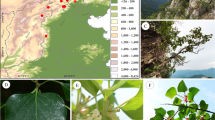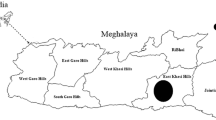Abstract
In order to understand the vegetative and reproductive phenological behaviour of Syzygium caryophyllatum, the knowledge of the factor influencing leaf flushing, maturation, leaf fall, flowering and fruiting of this tree species is required. The authors used field observations collected over 3 years (2012–2015) at Neeliyarkottam sacred grove, Kannur district, Western Ghats of Kerala, India, to characterize the relationship between phenological pattern and biotic and abiotic (climatic) factors. The relationship between phenological pattern of the selected species and abiotic variables such as precipitation and temperature exhibited significant variation among the species. Flowering begins from second week of March to till May with a peak in April followed by the fruiting. Hand pollination tests indicated that most of the fruits were developed through xenogamous pollination. The breeding test results indicated S. caryophyllatum is self-incompatible and out-crossing is fertile. The foraging activities of some common pollinators on S. caryophyllatum flowers were also studied. The main flower visitors and foragers include honey bees, different varieties of butterflies, wasps, carpenter bees, small flies, bugs and ants. The flowering and fruiting exclusively occur in the dry season and are followed by germination and establishment of seedlings during the subsequent rainy season. The authors conclude that the investigations on the reproductive phenology, floral biology, breeding systems and pollinator visitation are important due to population survival of the species and its evolutionary success.


Similar content being viewed by others
References
Parmesan C (2007) Influences of species, latitudes and methodologies on estimates of phenological response to global warming. Glob Change Biol 13:1860–1872
Parmesan C, Yohe G (2003) A globally coherent fingerprint of climate change impacts across natural systems. Nature 421:37–42
Root TL, Price JT, Hall KR, Schneider SH, Rosenzweig C, Pounds JA (2003) Fingerprints of global warming on wild animals and plants. Nature 421:57–60
Janetos AC, Chen RS, Arndt D, Kenney MA (2012) National climate assessment indicators: background, development and examples. US Global Change Research Program, USGCRP.gov, pp 1–59
Parry ML, Canziani OF, Palutikof JP, van der Linden PJ, Hanson CE, IPCC (2007) Climate change 2007: impacts, adaptation and vulnerability. Contribution of working group II to the fourth assessment report of the intergovernmental panel on climate change. Cambridge University Press, Cambridge
Okullo JBL, Hall JB, Obua J (2004) Leafing, flowering and fruiting of Vitellaria paradoxa sub sp. nilotica in savanna parklands in Uganda. Agrofor Syst 60(1):77–91
Milla R, Castro-Dıez P, Maestro-Martinez M, Montserrat-Marti G (2006) Costs of reproduction as related to the timing of phenological phases in the dioecious shrub Pistacia lentiscus L. Plant Biol 8:103–111
Morellato LPC, Talora DC, Takahasi A, Bencke CC, Romera EC, Zipparro VB (2000) Phenology of Atlantic rain forest trees: a comparative study. Biotropica 32(4b):811–823
Pires JPA, Marino NAC, Silva AG, Rodrigues PJFP, Freitas L (2018) Tree community phenodynamics and its relationship with climatic conditions in a lowland tropical rainforest. Forests 9:114
Ramírez F, Kallarackal J (2015) Responses of fruit trees to climate change. Springer, New York, p 42
Kallarackal J, Renuka R (2014) Phenological implications for the conservation of forest trees. In: Kapoor R, Kaur I, Koul M (eds) Plant reproductive biology and conservation. I.K International, New Delhi, pp 90–109
Daniel L, Vieira D, Scariot A (2006) Principles of natural regeneration of tropical dry forests for restoration. Restor Ecol 14:11–20
Luna-Nieves AL, Meave JA, Morellato LPC, Ibarra-Manriquez G (2017) Reproductive phenology of useful seasonally dry tropical forest trees: guiding patterns for seed collection and plant propagation in nurseries. For Ecol Manag 393:52–62
Koul MM, Bhatnagar AK (2007) Plant reproductive biology studies crucial for conservation. Curr Sci 92:1207
Bernardello G, Anderson GJ, Lopez SP, Cleland MA, Stuessy TF, Crawford DJ (1999) Reproductive biology of Lactoris fernandeziana (Lactoridaceae). Am J Bot 86:829–840
Broadhead J, Ong CK, Black CR (2003) Tree phenology and water availability in semi-arid agroforestry systems in Kenya. For Ecol Mang 180:61–73
Newstrom LE, Frankie GW, Baker HG (1994) A new classification for plant phenology based on flowering patterns in lowland tropical rain forest trees at La Selva Costa Rica. Biotropica 26:141–159
Sundarapandian SM, Chandrashekaran S, Swamy PS (2005) Phenological behaviour of selected tree species in tropical forests at Kodayar in the Western Ghats Tamil Nadu, India. Curr Sci 88:805–810
Nanda A, Prakasha HM, Krishna Murthy YL, Suresh HS (2011) Phenology of leaf flushing flower initiation and fruit maturation in dry deciduous and evergreen forests of Bhadra Wildlife Sanctuary Karnataka Southern India. Nature 9:89–99
Silva ALG, Pinheiro MCB (2007) Biologia floral e da polinizacao de quatro espécies de Eugenia L. (Myrtaceae). Acta Bot Bras 21:235–247
Mokake SE, Chuyong GB, Egbe AE, Tabot PT, Jumbam B, Ngotta Biyon BJ, Dibong SD (2018) Plant reproductive phenology following selective logging in a semideciduous tropical forest in the East Region of Cameroon. J Appl Biosci 128:12901–12919
Cruz AN, Meave JA, Bonfil C (2018) Reproductive phenology and seed germination in eight tree species from a seasonally dry tropical forest of Morelos, Mexico: implications for community oriented restoration and conservation. Trop Conserv Sci 11:1–14
Venugopal N, Marbaniang EJ (2017) Phenology, pollination mechanism, breeding system, seed dispersal and germination in Aquilaria malaccensis Lam. a threatened tropical evergreen forest tree of North East India. Int J Plant Reprod Biol 9(2):129–138
Beardsell DV, Knox RB, Williams EG (1993) Breeding system and reproductive success of Thryptomene calycina(Myrtaceae). Aust J Bot 41:333–353
Raju AJS, Krishna JR, Chandra PH (2014) Reproductive ecology of Syzygium alternifolium (Myrtaceae) an endemic and endangered tropical tree species in the southern Eastern Ghats of India. J Threat Taxa 6(9):6153–6171
Williams G, Adam P (2010) The flowering of Australia’s rain forests. CSIRO Publishing, Melbourne, p 200
Punekar SA, Kumaran NKP, Bhat HR (2010) Observations on an unusual behaviour in the Carpenter Bee Xylocopa aestuans (Latreille 1802) (Hymenoptera: Apidae) of the Western Ghats India. J Threat Taxa 2(10):1232–1233
Bailey P, Kevan PG (2017) Reproductive strategies matter for rare plant conservation: pollination, phenology, and mating in an endemic plant of the Sky Islands of Arizona, Erigeron lemmonii A. Gray (Lemmon’s Fleabane) (Asteraceae). West N Am Nat 77(3):385–397
Wenny DG (2000) Seed dispersal seed predation and seedling recruitment of a neotropical montane tree. Ecol Monogr 70:331–351
Acknowledgements
The first author thanks University Grant Commission for the award of meritorious fellowship. The corresponding author thanks partial financial support through University Grant Commission-Centre of Advanced Study (UGC-CAS), Department of Biotechnology—Interdisciplinary Programme of Life Sciences for Advanced Research (DBT-IPLS)—and Department of Science and Technology (DST)—Purse programmes.
Author information
Authors and Affiliations
Corresponding author
Ethics declarations
Conflict of interest
The authors declare that they have no conflict of interest to publish this manuscript.
Additional information
Significance statementSyzygium caryophyllatum is an endangered medicinal tree species endemic to Western Ghats. Understandings of vegetative and reproductive phenological behaviour provide clear ideas to population survival and also give effective conservation strategies in the natural forest. The present work emphasises the phenological pattern and environmental factors that affect the phenology of Syzygium caryophyllatum in the study area.
Rights and permissions
About this article
Cite this article
Nadarajan, S., Pujari, S.S. Phenological Patterns of an Endangered Tree Species Syzygium caryophyllatum in Western Ghats, India: Implication for Conservation. Proc. Natl. Acad. Sci., India, Sect. B Biol. Sci. 89, 1275–1281 (2019). https://doi.org/10.1007/s40011-018-1044-3
Received:
Revised:
Accepted:
Published:
Issue Date:
DOI: https://doi.org/10.1007/s40011-018-1044-3




